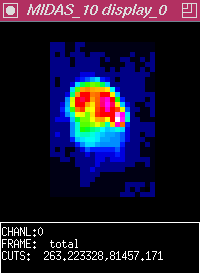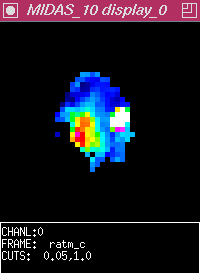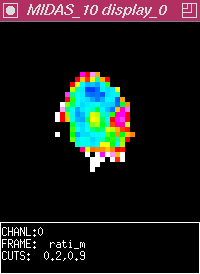


Below are three images of the Vela supernova remnant, as taken from the ROSAT All-Sky Survey. The intent is to look for spectrally "hard" emission associated with the Vela pulsar wind nebula.




They represent, in order from left to right, a total count rate map from the RASS (log stretch); a hardness ratio map of 0.5-0.9 to 0.1-0.4 keV channels (lin stretch); a hardness ratio map of 0.9-2.0 to 0.5-0.9 keV channels (lin stretch). Note that this is not the ideal choice of bands for studying the high energy continuum because there is a large amount of thermal emission from the supernova remnant shell which dominates over any possible pulsar nebular contribution. Unfortunately these are the bands available to the public (see reference below). The images are in galactic coordinates (with galactic north UP), each pixel being 40'x40'. The image intensity scale is given by the color bar and the "CUTS=" parameter in each image.
What can be seen is the Vela supernova remnant, which looks somewhat like a human heart. The Puppis supernova remnant, which is more distant, also appears as a smaller blob slightly to the right of center in all images. The hardness ratio maps are meant to indicate the spectral hardness or temperature of the emitting plasma. [Since this is a ratio of count rate maps, the hardness maps will be weighted by emission measure.]
In the central image (ratio of 0.5-0.9 to 0.1-0.4 keV) shows that the SNR is not uniform: there is harder emission at the bottom part of the remnant. This is probably because there is a lack of soft thermal shell emission from this part of the remnant compared to the other parts. [One suggestion is that the exterior medium is less dense on this side of the remnant, and so less shock heating takes place there as the remnant expands.]
The right-hand image (ratio of 0.9-2.0 to 0.5-0.9 keV) shows that the remnant is much more uniform, at least azimuthally. The center of the remnant shows as a yellow blob, indicating slightly harder emission than other parts of the remnant. [Puppis A, is much harder because of its distance and interstellar absorption, and appears as a red blob to the right.] The very fringes of the remnant appear to be hard, but have such very poor statistics that they are probably unreliable.
We might claim that the yellow blob is an extended plerion at the center of the Vela supernova remnant. We must consider, however, that the image has an angular resolution of 2 degrees (the field of view of ROSAT). The central blob has a diameter of approximately 2 degrees as well. This means that the central blob we observe could actually be a point-source like object, such as the compact nebula of the Vela pulsar, which is indeed very bright, small (~2 arcmin diameter), and spectrally hard. A proper analysis would need to do several things: use higher-energy channels, which are free from problems of shell thermal emission; exclude known point sources which are in the field before rebinning to a coarse scale. This would include the compact nebula and Puppis A if possible.
Data taken from study of diffuse X-ray emission, as published in S.L. Snowden, M.J. Freyberg, P.P. Plucinsky, J.H.M.M. Schmitt, J. Trümper, W. Voges, R.J. Edgar, D. McCammon, W.T. Sanders: Astrophysical Journal, Vol.454 (1995), pp.643-653. See the Mirror of the RASS Homepage at GSFC for more information on data.
 Return to COW Homepage
Return to COW Homepage
